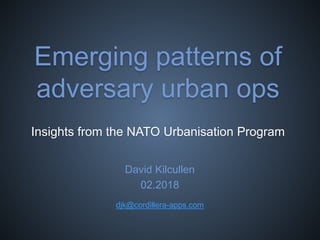RUSI Urban Warfare Conference Session 3 - David Kilcullen
- 1. Emerging patterns of adversary urban ops Insights from the NATO Urbanisation Program David Kilcullen 02.2018 djk@cordillera-apps.com
- 2. Infrastructure & Governance under stress The City as a System Environmental Degradation Poor Rural Infrastructure Lack of Access to Energy Poverty, hunger, disease Rural Crime and conflict Physical Economic Governmental RAPID, UNPLANNED URBANIZATION driven by: URBAN POVERTY CONFLICT prompted by: ABSENT GOVERNMENT POLITICAL INSTABILITY UNEMPLOYMENT CRIME RURAL HINTERLAND PERI-URBAN ZONE URBAN CORE & CBD TRANSITIONAL ZONE Emigration Shipping Offshore Extractives Trade Smuggling Piracy REMITTANCE system ILLICIT activity LICIT activity Diaspora OFFSHORE (INTERNATIONAL) FLOWS
- 3. 3 The enemy is not the only threatŌĆ”
- 4. The environment for adversaries ŌĆó Western air superiority, but limited weight of allied air power and less capable local ground forces ŌĆó Pervasive electronic surveillance but high traffic volumes ŌĆó High degree of connectivity (cellphones, internet, social media, gaming networks) enabling propaganda and C2 ŌĆó Pervasive smart handheld consumer electronics and support platforms ŌĆó Technological hugging of our systems (Google Earth, GPS) ŌĆó Technical and mechanical skill among urban populations
- 6. 6 ŌĆ”to full-scale Social Netwar?
- 8. Disruptive technology If a commercial product goes through a generation every two years, and the military cycle takes six years per generation, then in twelve years the military product goes from being four times as powerful as the competition to a quarter as powerfulŌĆ” Technologies developed for phones fit well with the requirements for small drones. Like phones, drones need miniature cameras, GPS navigation, and data processing power. Both share the same need for minimal size, weight, and power. A drone is simply a smartphone with wings, and the wings are the cheap part. David Hambling, Swarm Troopers, 2015, p4
- 9. 9 Mosul, Iraq ISIS grenade-carrying drone 02.2017
- 10. 10 Aleppo, Syria Homemade tank with video- enabled remote weapon station
- 11. 11
- 12. Emerging enemy approaches 1. Actions across the full breadth and depth of an urban/peri-urban/rural nodal matrix (urban centre, ŌĆ£beltsŌĆØ, exurbs, satellite cities) 2. Leaderless resistance, no ŌĆ£brainŌĆØ or HQŌĆöacephalous swarms, remote or stand-off control nodes, or one-way broadcast of operational guidance 3. ŌĆ£InfestationŌĆØ of urban environment (embedded in physical structures, hollow and interior spaces, and populations) 4. Large numbers of small multi-role platforms operating in a dynamic swarm 5. Modular organisations to lowest possible level (combat pairs) 6. Cooperative and remote engagement, through repurposing consumer electronics and industrial capacity 7. Cyber-kinetic opsŌĆöcyber as an adjunct integrated manoeuvre space 8. Improvisable capabilities (eg 3D printing), technological ŌĆ£huggingŌĆØ and high latent technological capacity in the population 9. Diaspora linkages and retaliation options, manipulation of social movements and public protests (incl. general strike) 10. No-go and no-see areas, control by interdiction, commuter insurgency, tactical use of terror to shape adversary deployment
- 13. Tactics in the urban defence ŌĆó Less focused on area defence of urban areas, more on actively defending surrounding rural zones (belts) ŌĆó Urban center may be economy of force, with main effort withheld and stronger counterattack and QRF operating in belts ŌĆó Little tendency to fight ŌĆ£last standŌĆØ defensive actions: area denial and active (flexible) defence, mobile mesh or network defence ŌĆó Likely to fade away in face of strong attack, then engage in rapid counterattacks using stay-behind groups or multi-planar reinfiltration ŌĆó Active patrollingŌĆöfighting and recce patrols, raids, use of many small actions to desensitize and shape defenders ahead of major strikes ŌĆó River-borne and seaborne attacks, typically by night and in bad weather
- 14. Tele-operated sniper rifle Near Kirkuk 01.2013
- 15. Tactics in the urban attack o Reflexive control: place the enemy in a cognitive box o Use of terrorism to manipulate (fix) defender laydown o Multiple small modular fighting groups o Urban, peri-urban and rural networked cells support a conventional manoeuvre force (underground, auxiliary, guerrilla [partisan] and main force) o Urban siege (ŌĆ£raid and holdŌĆØ) o Baited ambushes on relief force routes o Sabotage/denial of sea/air points of entry o House bombs, VBIEDs, drone IEDs, ŌĆ£artificial bird strikeŌĆØ 15
- 16. Months of logistic and ŌĆ£guerrilla diplomacyŌĆØ preparation. Infil of small urban guerrilla cells (5-15-man teams) to exurbs/outskirts from D-30. Exploitation of Eid festival. Three converging columns simultaneously atk from multiple axes, guerrillas attack key objs from rear. Focus on driving police and ANA to airport, then ambushing relief column.
- 17. Hybrid force modular tactical swarm ŌĆó 4-5 technicals, 6-8 dismounts per technical ŌĆó Heavy weapon in fire support or AAA role ŌĆó Fluid ŌĆ£light cavalryŌĆØ tactics ŌĆó 2-3 precision indirect fire weapons ŌĆó Captive drones & loitering munitions ŌĆó Cyber capabilities embedded ŌĆó Specialist IED, sniper, anti-armour teams ŌĆó Networked, collaborative or autonomous modes
- 18. Urban insurgency & terrorism ŌĆó Multi-path re-infiltration of previously cleared areas ŌĆó Mobile IEDs repositioned by drone ŌĆó Commuter insurgency, urban areas denied not defended ŌĆó Anti-aircraft ambushes ŌĆó Runway and harbour denial operations ŌĆó Snipers, mortars in depth (keyhole shots, observers forward or remotely located using Google Earth/GPS/GLONASS) ŌĆó Anti-tank kill teams working in on armour from flanks ŌĆó Tunneling and placement of IEDs under buildings ŌĆó The tunnel as a network (cf. ATN approach to IEDs) ŌĆó Mounted counterattack in technicals against HQs ŌĆó House bombs, SVBIEDs, IEDs in thick defensive clusters
- 19. Armored SVBIED=precision guided missile West of Erbil, Iraq ISIS 8-ton ANFO SVBIED 01.2015















![Tactics in the urban attack
o Reflexive control: place the enemy in a cognitive box
o Use of terrorism to manipulate (fix) defender laydown
o Multiple small modular fighting groups
o Urban, peri-urban and rural networked cells support a
conventional manoeuvre force (underground, auxiliary,
guerrilla [partisan] and main force)
o Urban siege (ŌĆ£raid and holdŌĆØ)
o Baited ambushes on relief force routes
o Sabotage/denial of sea/air points of entry
o House bombs, VBIEDs, drone IEDs, ŌĆ£artificial bird strikeŌĆØ
15](https://image.slidesharecdn.com/kilcullenrusifeb18-180209130007/85/RUSI-Urban-Warfare-Conference-Session-3-David-Kilcullen-15-320.jpg)





